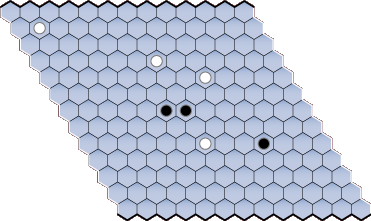Hex

Hex is a board game played by two players on a hexagonal grid, usually in the shape of an 11 × 11 rhombus. It was invented by Piet Hein in 1942 and independently by John Nash in 1948. Hein said that the game occurred to him while contemplating the Four-Color Problem and it soon became popular in Denmark under the name Polygon. Nash's version was played by math students at Princeton and a number of other American campuses.
Players use differently colored pieces – say, red and blue. They take alternate turns placing a piece of their color inside a hexagon, filling in that hexagon with their color. Red's goal is to form a red path connecting the top and bottom sides of the parallelogram; Blue's goal is to form a path connecting the left and right sides. The game can never end in a tie, a fact found by Nash: the only way to prevent your opponent from forming a connecting path is to form a path yourself. When the sides of the grid are equal, the game favors the first player and the first player has a winning strategy. There are two ways to make the game fairer. One is to make the second player's sides closer together, playing on a parallelogram rather than a rhombus; however, this has been proven to result in a win for the second player, so it theoretically doesn't improve matters. A better way is to allow the second player to choose his color after the first player makes the first move or to make the first three moves, which encourages the first player to intentionally even out the game.


